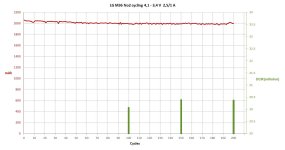Fantastic chart.docware said:Your choice LG M36 seems to be for such case better option than Panasonic PF.
Anyone know the respective LI chemistries used?
It seems to me, the only practical differences are:
1. slightly higher voltage for each point of SoC, and
2. slightly higher capacity, assuming a 3.2V cutoff at that 1C discharge rate
As flippy keeps pointing out, acquisition cost is a non-trivial factor for most
while I would consider those two data points to be pretty unimportant.
What trusted sources would you all recommend for these two cells, for delivery to the US?
And any ideas about relative longevity? especially at under 1C rate discharge usage. . .
That to me is really the **only** factor that justifies a higher price.





